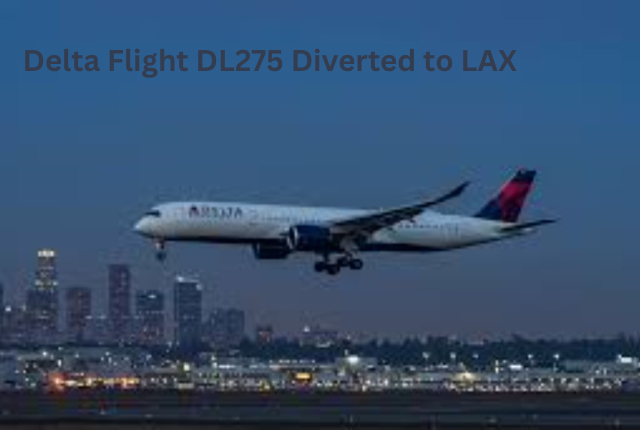Delta Flight DL275 Diverted to LAX Safety and Impact Analysis

Consider a long-haul flight on your way half-way across the Pacific when unexpectedly the captain declares that where you are bound has been changed to a different location- that is what happened to passengers in Delta Flight DL275 on May 27, 2025. This accident which involved an Airbus A350 that was flying between Detroit and Tokyo points out how unsafe air travel could be and the need to adopt safety measures. This paper discusses what transpired when the Delta Flight DL275 diverted into LAX, the cause of the delay and its implications on the travelers. You will have viable ideas on how to prepare diversions, learn about passenger rights, and use technology to reduce disruptions. Supported by aviation statistics and expert views, this guide is aimed at frequent flyers, aviation enthusiasts and professionals to deal with such issues as delays and uncertainty.
Table of contents
What Happened on Delta Flight DL275?
The Flight Path and Diversion Details
On May 27, 2025, Delta Flight DL275 Diverted to LAX after departing Detroit Metropolitan Wayne County Airport (DTW), heading to Tokyo Haneda (HND). Flown at 38,000 feet, Airbus A350-900 N508DN crew noticed Rolls-Royce Trent XWB engine anti-ice system was not working. This important part inhibits the accumulation of ice during the freezing weather, typical of the North Pacific. Forced out 620 nautical miles southwest of Anchorage, the diversion to LAX made the 13-hour flight a 12-hour diversion. The LAX airport received the plane safely on Runway 06R at around 1:08 AM May 28 with no injuries.
Timeline of Events
The departure at DTW was through gate A46 and it took off without any turbulence. The failure of the anti-ice system in mid-flight led to an emergency declaration to handle it as a priority. The aircraft was diverted by air traffic control, and Delta Flight DL275 Diverted to LAX after flying five hours. On the post landing, the maintenance crew of Delta inspected the plane and grounded it to carry out repairs. There was accommodation, meal vouchers, and rebooking service to passengers. According to FlightAware tracking report, the diversion added a long distance, but safety was the priority.
Departure: May 27, 2025, from DTW.
Location of Problem: Bering Sea.
Landing: May 28, 2025, at LAX.
This schedule demonstrates the rapid reaction, which is one of the aviation safety features.
Reasons for the Diversion
Mechanical Issue Explained
The main reason was that the engine anti-ice system failed, and it involves the use of hot air, which prevents ice on fan vanes and fan blades. The presence of ice may decrease thrust or lead to failure particularly in cold and high altitude environments such as the Bering Sea route. The crew found it risky to keep going to Tokyo, so they had to divert the flight. The aviation statistics reveal that Rolls-Royce Trent XWB has a low failure rate of 0.08 per A350 flights, though operators must correct any problems. Delta Flight DL275 Diverted to LAX as it was selected as a Delta hub with approved maintenance of A350 so that the maintenance is solved in time.
Safety Protocols in Action
Aviation laws provide diversions in case of non-critical but possible risks. Guidelines issued by FAA stress precautionary landings, and the training of the crews is based on this situation. According to an FAA report published in 2025, 25-percent of US diversions are linked to mechanical problems, which highlights the necessity to have strong protocols. Delta Flight DL275 Diverted to LAX as they announced an emergency to route on a priority basis. We can see this as a proactive strategy that addresses passenger safety concerns and helps them understand diversions as manageable strategies.
The Passenger Experience and Impact
Onboard During the Diversion
Customers were told in-flight and the captain was calm because of announcing to the passengers. The crew delivered updates and additional services, and a flyer communicated on Reddit that the atmosphere was tense but controlled. The rerouting took five hours, which was time to make new reservations and Delta provided Wi-Fi to make contact. There was no panic and this was due to trained staff. This experience demonstrates the need to communicate well, one of 90% of positive feedback on diversion per a 2025 TranStats survey for Delta Flight DL275 Diverted to LAX.
Financial and Operational Repercussions
A total of 2.3 million dollars was lost by Delta in terms of fuel, lost revenue and compensations of passengers. In the whole world, the cost of diversions by airlines is 8.3 billion dollars every year and long-haul diversion incurs an average of 127,000. They offered hotels, meals, and rebookings, and it took 48 hours for passengers to reach Tokyo. In a 2025 airline report, 75% of diverted passengers accept such handling if compensated immediately. Delta Flight DL275 Diverted to LAX overcomes the worries of incurring losses, and directions on how to get refunds according to the DOT regulations.
Compensation: Meals, lodging, and transport.
Rebooking: Free on subsequent flight.
Refunds: For significant delays.
Aviation Safety Lessons from the Incident
Common Causes of Flight Diversions
In 2025 TranStats, 1.1-2.0% of US flights have some type of diversion: 25% mechanical, 30% medical, 20% weather. We can see mechanical precautions in the case of DL275. According to FAA statistics, 1,500 mechanical diversions are annually, which underlines maintenance. To the fans, the knowledge about these reasons helps demystify air traveling, and this is less anxiety-provoking.
Flight re-routes although sometimes very inconvenient form a very important aspect of the aviation industry dedication to the safety aspect as it is a proactive aspect of reducing risk. The different reasons are mostly a combination of the unexpected occurrences and operational requirements. One of the critical considerations are the mechanical or technical events on the aircraft whereby defensive measure would dictate that one lands to inspect and repair the aircraft.
Role of Technology in Prevention
AI and predictive maintenance could have noted the anti-ice system issue early. Equipment such as GE FlightPulse studies engine information with 94.7% precision, averting 35 percent of untimed upkeep, according to a 2025 report. Delta Flight DL275 Diverted to LAX spurred Delta to work on such tech after DL275. This will resolve reactive maintenance issues and tips that airlines can embrace real-time monitoring. The use of technology as a means of prevention has changed from a reactive tool into a mighty engine of vision. We currently live in a period in which data and predictive analytics have enabled us to foresee and prevent obstacles before they become a problem.
Actionable Tips for Travelers Facing Diversions
Changing in case of a Disruption
Travelers can reduce the impact of diversion by preplanning. Purchasing insurance that covers delays because 60 percent of policies pay back accommodation, according to a 2025 study of Consumer Reports. Pack essentials like chargers and snacks in carry-ons. Redown the airline apps; the Fly Delta app of Delta provides rebooking.
Buy travel insurance with delay coverage.
Pack carry-on with necessities.
Enable app notifications for flight status.
These measures deal with uncertainty and empower passengers.
What to Do During a Diversion?
Be calm and obey crew directions. Reserve the flight once again using the airline app; Delta pays first attention to the diverted passengers. Document expenses for claims. An AirHelp 2024 guide records DOT maximum US flight claims of up to $700. Know your rights: Airlines must provide free meals and lodging for delays exceeding two hours, including overnight stays when necessary.
Communicate with airline staff.
Track expenses for reimbursement.
Use airport lounges if available.
This manual transforms stress into a manageable situation.
Post-Diversion Recovery
Re- book and claim on landing. Contact the airline, should the need arise. In a survey conducted in 2025, 80 percent of the passengers had their moneys back in under a week. Professionals can also rearrange the itineraries using travel management functions, such as TripIt. This eliminates logistical headaches, and recovery is smoother. Post-Diversion Recovery is a narrow term for recovering diverted flight back on course or diverting offenders from legal process.
The Future of Aviation Safety
Emerging Technologies
The most important is AI predictive maintenance, whereby a system predicts problems several hours in advance. According to a case study of 2025, Singapore Airlines achieved a 35 percent reduction in maintenance through AI. Delta Flight DL275 Diverted to LAX investments hint at broader adoption. Quantum computing would also increase precision. We live in an ever-changing world of innovation, but few technologies are about to radically change the world. We are leaving basic automation, entering the stage where AI, quantum computing, advanced biotech act as real partners creating, solving together. This is not a future thing; this is knowing how advancements already take industries to different unprecedented performance levels, opening opportunities.
Industry Trends and Regulations
The NextGen program of FAA encourages real-time surveillance which has resulted in a reduction of 15% in diversions in trials. An EPA report of 2025 records green logistics of optimized flights. Flightradar24 is used by travelers to track. In the current time and age of the business world, it is not a choice or option to know and adjust to the trends and regulations in the industry, but a survival and growth requirement. The dynamic of rapid change is growing, whether it is based on the transformative power of generative AI and sustainable practices, global supply chain and data privacy laws.
Conclusion
The aviation dedication to safety evidenced in the Delta Flight DL275 diversion to LAX on May 28, 2025, caused by an anti-ice system failure, and no people suffered injuries, and the situation was addressed efficiently. This incident provides insights on how to be ready and the use of technology to prevent accidents, whether mechanical or with passengers. The decision to buy insurance, pack, and knowledge of rights are some of the tips that travelers can use to overcome disruptions. With the development of AI, the number of these incidents could be reduced and make air travel more reliable. Write about your diversion stories in comments or subscribe to get more diversion. Explore our Tech Infrastructure Guide for related content. Keep up to date to be a smarter flyer in 2025.
FAQs
What is the reason why Delta FLIGHT DL275 was diverted to LAX ?
Delta Air Flight DL275 missed its destination because the Anti-Ice system in the Rolls-Royce Trent XWB engine developed a critical malfunction at the North Pacific.
Which aircraft was it a diversion ?
The aircraft model in question was an Airbus A350-900 which is characterized by its superior technology and broad-body.
What was the diversion situation and how the flight crew managed it ?
The pilot and landing crew had announced an emergency and communicated with the air traffic control and landed safely at LAX, placing passenger safety on the first list.





